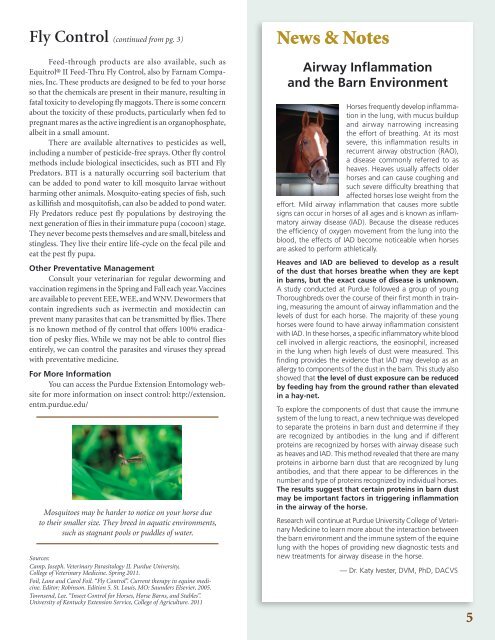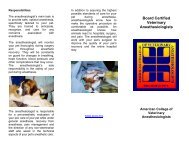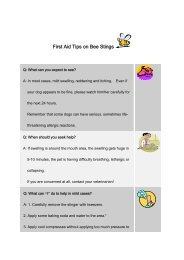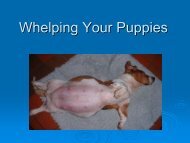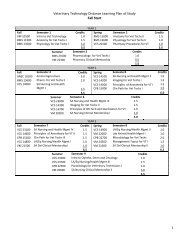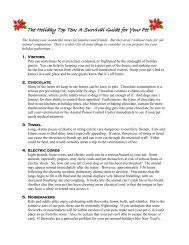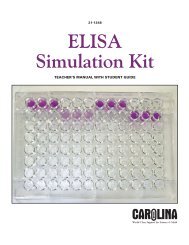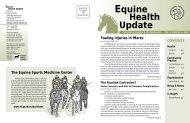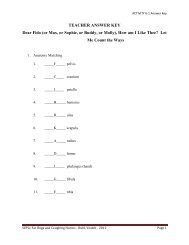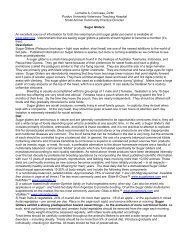EQUINE HEALTH UPDATE - Purdue University School of Veterinary ...
EQUINE HEALTH UPDATE - Purdue University School of Veterinary ...
EQUINE HEALTH UPDATE - Purdue University School of Veterinary ...
You also want an ePaper? Increase the reach of your titles
YUMPU automatically turns print PDFs into web optimized ePapers that Google loves.
Fly Control (continued from pg. 3)Feed-through products are also available, such asEquitrol® II Feed-Thru Fly Control, also by Farnam Companies,Inc. These products are designed to be fed to your horseso that the chemicals are present in their manure, resulting infatal toxicity to developing fly maggots. There is some concernabout the toxicity <strong>of</strong> these products, particularly when fed topregnant mares as the active ingredient is an organophosphate,albeit in a small amount.There are available alternatives to pesticides as well,including a number <strong>of</strong> pesticide-free sprays. Other fly controlmethods include biological insecticides, such as BTI and FlyPredators. BTI is a naturally occurring soil bacterium thatcan be added to pond water to kill mosquito larvae withoutharming other animals. Mosquito-eating species <strong>of</strong> fish, suchas killifish and mosquit<strong>of</strong>ish, can also be added to pond water.Fly Predators reduce pest fly populations by destroying thenext generation <strong>of</strong> flies in their immature pupa (cocoon) stage.They never become pests themselves and are small, biteless andstingless. They live their entire life-cycle on the fecal pile andeat the pest fly pupa.Other Preventative ManagementConsult your veterinarian for regular deworming andvaccination regimens in the Spring and Fall each year. Vaccinesare available to prevent EEE, WEE, and WNV. Dewormers thatcontain ingredients such as ivermectin and moxidectin canprevent many parasites that can be transmitted by flies. Thereis no known method <strong>of</strong> fly control that <strong>of</strong>fers 100% eradication<strong>of</strong> pesky flies. While we may not be able to control fliesentirely, we can control the parasites and viruses they spreadwith preventative medicine.For More InformationYou can access the <strong>Purdue</strong> Extension Entomology websitefor more information on insect control: http://extension.entm.purdue.edu/Mosquitoes may be harder to notice on your horse dueto their smaller size. They breed in aquatic environments,such as stagnant pools or puddles <strong>of</strong> water.Sources:Camp, Joseph. <strong>Veterinary</strong> Parasitology II. <strong>Purdue</strong> <strong>University</strong>,College <strong>of</strong> <strong>Veterinary</strong> Medicine. Spring 2011.Foil, Lane and Carol Foil. “Fly Control”. Current therapy in equine medicine.Editor: Robinson. Edition 5. St. Louis, MO: Saunders Elsevier, 2005.Townsend, Lee. “Insect Control for Horses, Horse Barns, and Stables”.<strong>University</strong> <strong>of</strong> Kentucky Extension Service, College <strong>of</strong> Agriculture. 2011News & NotesAirway Inflammationand the Barn EnvironmentHorses frequently develop inflammationin the lung, with mucus buildupand airway narrowing increasingthe effort <strong>of</strong> breathing. At its mostsevere, this inflammation results inrecurrent airway obstruction (RAO),a disease commonly referred to asheaves. Heaves usually affects olderhorses and can cause coughing andsuch severe difficulty breathing thataffected horses lose weight from theeffort. Mild airway inflammation that causes more subtlesigns can occur in horses <strong>of</strong> all ages and is known as inflammatoryairway disease (IAD). Because the disease reducesthe efficiency <strong>of</strong> oxygen movement from the lung into theblood, the effects <strong>of</strong> IAD become noticeable when horsesare asked to perform athletically.Heaves and IAD are believed to develop as a result<strong>of</strong> the dust that horses breathe when they are keptin barns, but the exact cause <strong>of</strong> disease is unknown.A study conducted at <strong>Purdue</strong> followed a group <strong>of</strong> youngThoroughbreds over the course <strong>of</strong> their first month in training,measuring the amount <strong>of</strong> airway inflammation and thelevels <strong>of</strong> dust for each horse. The majority <strong>of</strong> these younghorses were found to have airway inflammation consistentwith IAD. In these horses, a specific inflammatory white bloodcell involved in allergic reactions, the eosinophil, increasedin the lung when high levels <strong>of</strong> dust were measured. Thisfinding provides the evidence that IAD may develop as anallergy to components <strong>of</strong> the dust in the barn. This study alsoshowed that the level <strong>of</strong> dust exposure can be reducedby feeding hay from the ground rather than elevatedin a hay-net.To explore the components <strong>of</strong> dust that cause the immunesystem <strong>of</strong> the lung to react, a new technique was developedto separate the proteins in barn dust and determine if theyare recognized by antibodies in the lung and if differentproteins are recognized by horses with airway disease suchas heaves and IAD. This method revealed that there are manyproteins in airborne barn dust that are recognized by lungantibodies, and that there appear to be differences in thenumber and type <strong>of</strong> proteins recognized by individual horses.The results suggest that certain proteins in barn dustmay be important factors in triggering inflammationin the airway <strong>of</strong> the horse.Research will continue at <strong>Purdue</strong> <strong>University</strong> College <strong>of</strong> <strong>Veterinary</strong>Medicine to learn more about the interaction betweenthe barn environment and the immune system <strong>of</strong> the equinelung with the hopes <strong>of</strong> providing new diagnostic tests andnew treatments for airway disease in the horse.— Dr. Katy Ivester, DVM, PhD, DACVS5


